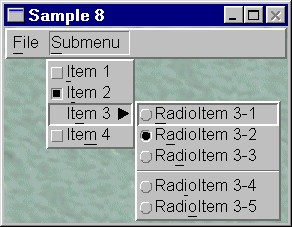
The ExitCB() callback, linked to the ‘Exit’ item in the ‘File’ menu, causes the program termination when it is selected. The ToggleItemCB() callback is called when the corresponding toggle-item is selected. The item’s check status is reported as the second argument of the callback call.
/* C version */ #include <stdio.h> #include <stdlib.h> #include <string.h> #include "mgui.h" void ExitCB(MENU_ITEM item, MVALUE status, void *b) { MShellDestroy((MOBJECT)b); MGUITerm(); exit(0); } void ToggleItemCB(MENU_ITEM item, MVALUE status, void *udata) { char str[128]; sprintf(str, "The selected menu item\nhas been %s", (status ? "Activated" : "Deactivated")); MMessageDialog("", str, "Ok", NULL); } void RadioItemCB(MENU_ITEM item, MVALUE status, void *udata) { char str[128]; if (!status) return; sprintf(str, "Menu item <%lx> selected", item); MMessageDialog("", str, "Ok", NULL); } void MGUIMain(int argc, char **argv) { MOBJECT shell, menubar, menu, submenu; MENU_ITEM pd_item_id; shell = MCreateShell("Sample 8", SF_NO_CLOSE); MObjectSetBackgroundImageFile(shell, "tile5.bmp", BI_TILED); menubar = MCreateMenuBar(shell, HELV_L_FONT); MMenuBarSetAcc(menubar, F10); menu = MCreateMenu(menubar, "File"); MMenuAddItem(menu, "Quit", ExitCB, shell); menu = MCreateMenu(menubar, "Submenu"); MMenuAddToggleItem(menu, "Item 1", ToggleItemCB, NULL); MMenuAddToggleItem(menu, "Item 2", ToggleItemCB, NULL); pd_item_id = MMenuAddItem(menu, "Item 3", NULL, NULL); MMenuAddToggleItem(menu, "Item 4", ToggleItemCB, NULL); submenu = MCreateSubMenu(pd_item_id); MMenuAddRadioItem(submenu, "RadioItem 3-1", RadioItemCB, NULL); MMenuAddRadioItem(submenu, "RadioItem 3-2", RadioItemCB, NULL); MMenuAddRadioItem(submenu, "RadioItem 3-3", RadioItemCB, NULL); MMenuAddSeparator(submenu); MMenuAddRadioItem(submenu, "RadioItem 3-4", RadioItemCB, NULL); MMenuAddRadioItem(submenu, "RadioItem 3-5", RadioItemCB, NULL); MShellRealize(shell); MMainLoop(); }
#include <stdio.h>
#include <string.h>
#include "mguipp.h"
class CaAppl : public CmAppl {
public:
void start(int, char **);
};
CaAppl appInstance;
class CaMainWindow : public CmShell {
public:
CaMainWindow(const char *title, int flags);
void toggleItemCB(int status);
void radioItemCB(int status);
void exitCB(int);
};
void CaMainWindow::exitCB(int)
{
delete this;
CmAppl::end(0);
}
void CaAppl::start(int argc, char **argv)
{
CaMainWindow *win = new CaMainWindow("Example 8", SF_NO_CLOSE);
win->realize();
mainLoop();
}
void CaMainWindow::toggleItemCB(int status)
{
char str[128];
sprintf(str, "The selected menu item\nhas been %s",
(status ? "Activated" : "Deactivated"));
messageDialog("", str, "Ok", NULL);
}
void CaMainWindow::radioItemCB(int status)
{
char str[128];
if (!status)
return;
sprintf(str, "Menu item has been selected");
messageDialog("", str, "Ok", NULL);
}
CaMainWindow::CaMainWindow(const char *title, int flags)
: CmShell(title, flags)
{
CmMenuBar *menubar;
CmMenu *menu, *submenu;
CmMenuItem *item;
setBackgroundImageFile("tile5.bmp", BI_TILED);
menubar = new CmMenuBar(this, HELV_L_FONT);
menubar->setAcceleratorKey(F10);
menu = new CmMenu(menubar, "File");
new CmMenuItem(menu, "Quit", this, (MENUITEM_CB)exitCB);
menu = new CmMenu(menubar, "Submenu");
new CmMenuToggleItem(menu, "Item 1", this, (MENUITEM_CB)toggleItemCB);
new CmMenuToggleItem(menu, "Item 2", this, (MENUITEM_CB)toggleItemCB);
item = new CmMenuItem(menu, "Item 3");
new CmMenuToggleItem(menu, "Item 4", this, (MENUITEM_CB)toggleItemCB);
submenu = new CmMenu(item);
new CmMenuRadioItem(submenu, "RadioItem 3-1", this, (MENUITEM_CB)radioItemCB);
new CmMenuRadioItem(submenu, "RadioItem 3-2", this, (MENUITEM_CB)radioItemCB);
new CmMenuRadioItem(submenu, "RadioItem 3-3", this, (MENUITEM_CB)radioItemCB);
new CmMenuSeparator(submenu);
new CmMenuRadioItem(submenu, "RadioItem 3-4", this, (MENUITEM_CB)radioItemCB);
new CmMenuRadioItem(submenu, "RadioItem 3-5", this, (MENUITEM_CB)radioItemCB);
}
